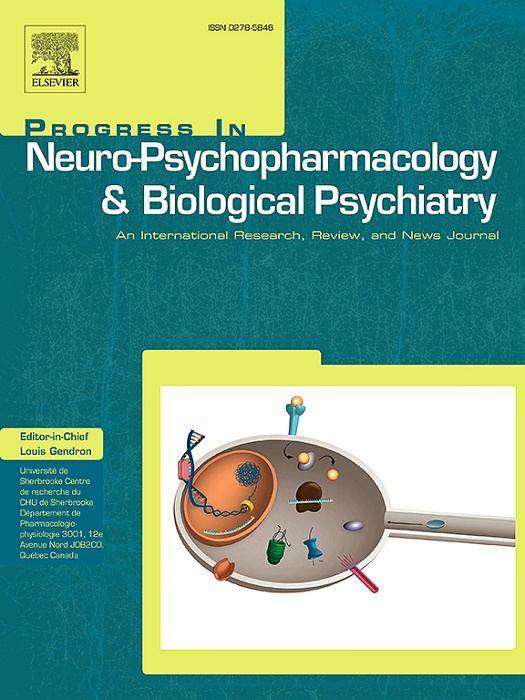Alcohol drinking is associated with greater calcium activity in mouse central amygdala dynorphin-expressing neurons
IF 3.9
2区 医学
Q1 CLINICAL NEUROLOGY
Progress in Neuro-Psychopharmacology & Biological Psychiatry
Pub Date : 2025-07-11
DOI:10.1016/j.pnpbp.2025.111445
引用次数: 0
Abstract
Alcohol use disorder (AUD) is a chronic disease that poses significant economic burden and health risks. It is pivotal to better understand brain mechanisms engaged by alcohol that promote misuse. The central amygdala (CeA) has emerged as a key mediator of excessive alcohol consumption in preclinical models. A dynorphin-expressing subpopulation within the CeA (CeADyn) has been implicated in excessive alcohol drinking, yet how cellular activity of CeADyn neurons relates to ongoing alcohol drinking is not well-understood. The current study interrogated the engagement of CeADyn neurons in male and female mice during voluntary alcohol consumption using fiber photometry and compared this cellular response with that of other solutions having similar motivational and/or taste characteristics. Activity of a calcium sensor, GCaMP7f, expressed in mouse CeADyn neurons was recorded and time-locked to drinking bouts. Advanced fiber photometry normalization and mixed modeling methods were developed to better resolve effects, revealing relatively large increases in CeADyn neuron calcium transients after bouts of alcohol drinking compared to water or sucrose drinking. This indicates that these neurons are uniquely engaged during alcohol consumption. Alcohol-specific drinking behavior (i.e., longer bout durations) did not fully explain signal differences between alcohol and other solutions nor did the relatively increased alcohol response diminish over time. No other conditions or solutions tested reproduced the pronounced change in CeADyn activity associated with alcohol drinking. These findings support the presence of a unique functional signature for alcohol in a cell population known to control excessive alcohol drinking and further advance fiber photometric normalization and analytical methods.
饮酒与小鼠中央杏仁核表达运动啡的神经元中钙活性增加有关。
酒精使用障碍(AUD)是一种造成重大经济负担和健康风险的慢性疾病。更好地了解酒精导致滥用的大脑机制是至关重要的。在临床前模型中,中央杏仁核(CeA)已成为过量饮酒的关键中介。CeA (CeADyn)中表达啡肽的亚群与过度饮酒有关,但CeADyn神经元的细胞活动与持续饮酒的关系尚不清楚。目前的研究使用纤维光度法询问了雄性和雌性小鼠在自愿饮酒期间CeADyn神经元的参与情况,并将这种细胞反应与具有类似动机和/或味道特征的其他溶液进行了比较。在小鼠CeADyn神经元中表达的钙传感器GCaMP7f的活性被记录下来,并在饮酒时被锁定。为了更好地解决这一问题,研究人员开发了先进的纤维光度归一化和混合建模方法,揭示了饮酒后CeADyn神经元钙瞬态的增加相对于喝水或蔗糖。这表明这些神经元在饮酒时是唯一参与的。酒精特异性饮酒行为(即更长的发作持续时间)并不能完全解释酒精和其他溶液之间的信号差异,也没有随着时间的推移而减少相对增加的酒精反应。没有其他测试条件或溶液重现与饮酒相关的CeADyn活性的显著变化。这些发现支持了酒精在已知控制过量饮酒的细胞群中独特功能特征的存在,并进一步推进了纤维光度归一化和分析方法。
本文章由计算机程序翻译,如有差异,请以英文原文为准。
求助全文
约1分钟内获得全文
求助全文
来源期刊
CiteScore
12.00
自引率
1.80%
发文量
153
审稿时长
56 days
期刊介绍:
Progress in Neuro-Psychopharmacology & Biological Psychiatry is an international and multidisciplinary journal which aims to ensure the rapid publication of authoritative reviews and research papers dealing with experimental and clinical aspects of neuro-psychopharmacology and biological psychiatry. Issues of the journal are regularly devoted wholly in or in part to a topical subject.
Progress in Neuro-Psychopharmacology & Biological Psychiatry does not publish work on the actions of biological extracts unless the pharmacological active molecular substrate and/or specific receptor binding properties of the extract compounds are elucidated.

 求助内容:
求助内容: 应助结果提醒方式:
应助结果提醒方式:


